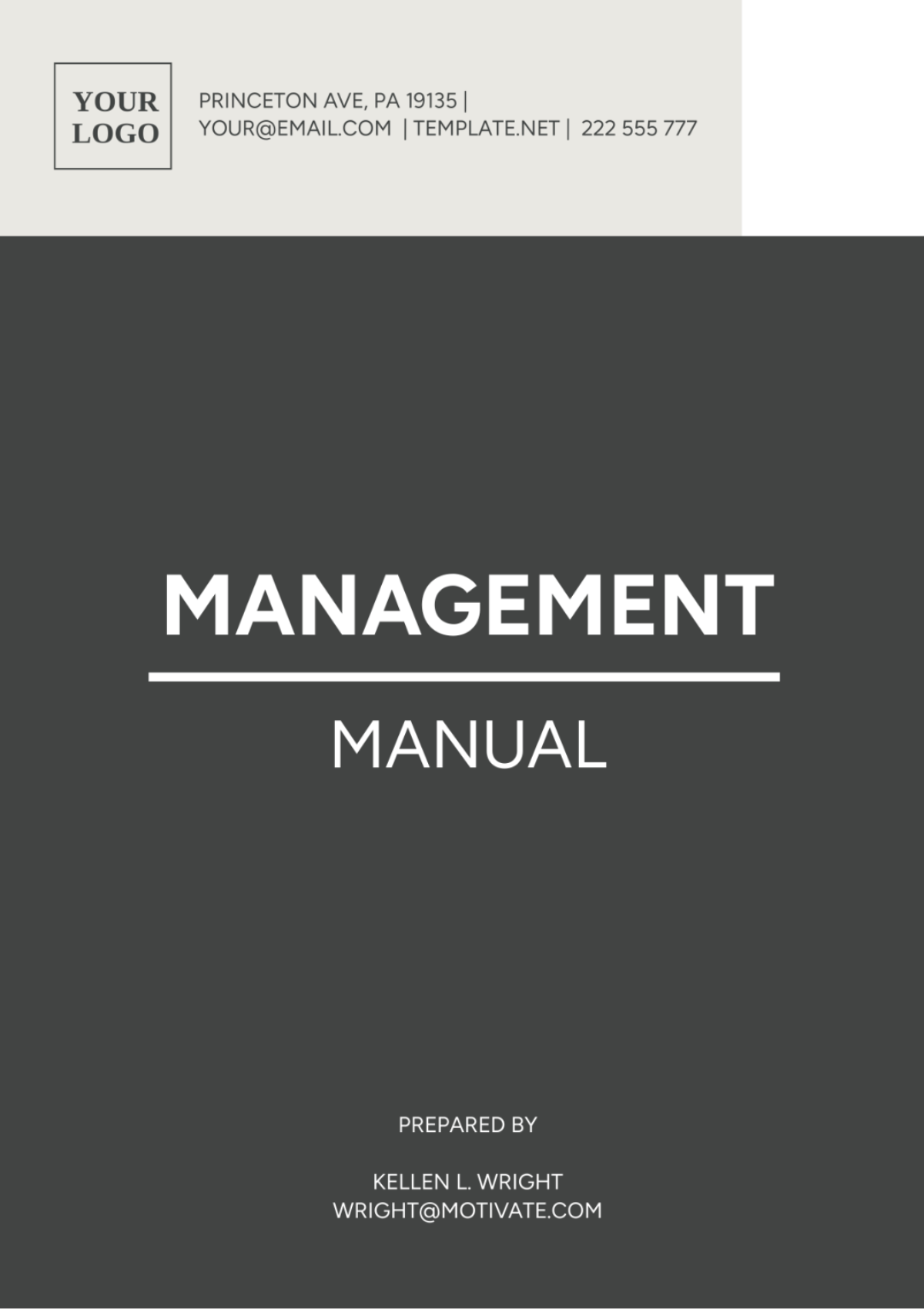Free Management Manual

Prepared By | [YOUR NAME] |
|---|---|
Company | [YOUR COMPANY NAME] |
Department | [YOUR DEPARTMENT] |
Date | [CURRENT DATE] |
I. Introduction
In this section, [YOUR COMPANY NAME] presents the Management Manual, a comprehensive guide designed to streamline and optimize managerial processes within the organization. This manual serves as a foundational document for [YOUR DEPARTMENT], offering valuable insights, procedures, and best practices for effective management.
Effective management is crucial for driving organizational success, fostering innovation, and ensuring operational efficiency. By adhering to the principles outlined in this manual, managers can enhance their leadership skills, promote teamwork, and achieve strategic objectives.
II. Organizational Structure
A. Overview
[YOUR COMPANY NAME] follows a hierarchical organizational structure to facilitate clear communication, decision-making, and accountability. This structure comprises various departments, teams, and roles, each with defined responsibilities and reporting lines.
B. Departmental Roles and Responsibilities
Executive Management
Overseeing the overall direction and strategy of the organization.
Setting goals, objectives, and performance metrics.
Human Resources
Recruiting, onboarding, and developing talent.
Managing employee relations and ensuring compliance with labor laws.
Finance
Budgeting, forecasting, and financial planning.
Monitoring expenses, revenue, and profitability.
Operations
Managing day-to-day activities and processes.
Enhancing operational efficiency and productivity.
C. Communication Channels
Effective communication is essential for collaboration, problem-solving, and decision-making. [YOUR COMPANY NAME] employs various communication channels, including:
Email: For formal correspondence and documentation.
Meetings: To discuss projects, initiatives, and challenges.
Intranet: For sharing updates, policies, and resources.
Instant Messaging: For quick queries and informal communication.
III. Policies and Procedures
A. Code of Conduct
[YOUR COMPANY NAME] is committed to maintaining a professional and ethical work environment. Our Code of Conduct outlines the principles and standards expected of all employees, including:
Integrity and honesty in all dealings.
Respect for colleagues, clients, and stakeholders.
Compliance with laws, regulations, and company policies.
Confidentiality and protection of company assets.
B. Performance Management
Performance management is a continuous process aimed at aligning individual goals with organizational objectives. Key components include:
Goal setting and performance expectations.
Regular feedback and coaching sessions.
Performance evaluations and recognition programs.
Development plans and training opportunities.
IV. Resources and Tools
A. Technology Infrastructure
[YOUR COMPANY NAME] provides employees with access to state-of-the-art technology infrastructure to support their daily tasks and responsibilities. This includes:
High-speed internet connectivity.
Secure network systems and data storage.
Collaboration tools such as project management software and video conferencing platforms.
IT support services for troubleshooting and assistance.
B. Training and Development
Investing in employee development is paramount to the success of [YOUR COMPANY NAME]. We offer a range of training programs and resources to enhance skills, knowledge, and professional growth. These include:
Onboarding and orientation programs for new hires.
Skill-specific training workshops and seminars.
Leadership development programs for aspiring managers.
Online learning platforms for self-paced learning opportunities.
V. Risk Management
A. Identification and Assessment
Risk management is integral to safeguarding organizational interests and assets. [YOUR COMPANY NAME] follows a structured approach to identify, assess, and mitigate risks across various areas, including:
Financial risks such as market fluctuations and liquidity concerns.
Operational risks related to processes, systems, and infrastructure.
Compliance risks arising from regulatory changes and legal requirements.
Reputational risks associated with public perception and stakeholder trust.
B. Risk Mitigation Strategies
Once risks are identified and assessed, [YOUR COMPANY NAME] implements appropriate mitigation strategies to minimize potential impacts. These strategies may include:
Risk transfer through insurance policies and contracts.
Risk avoidance by discontinuing high-risk activities or partnerships.
Risk reduction through process improvements and controls.
Risk acceptance when the cost of mitigation outweighs the potential impact.
VI. Decision-Making Framework
A. Data-Driven Decision Making
[YOUR COMPANY NAME] emphasizes the importance of data-driven decision making to enhance accuracy, efficiency, and effectiveness. Managers are encouraged to leverage data analytics, market research, and performance metrics to inform strategic decisions. Key steps in the decision-making process include:
Defining the problem or opportunity.
Gathering relevant data and information.
Analyzing and interpreting data to identify trends and patterns.
Evaluating alternative solutions and their potential outcomes.
Implementing the chosen solution and monitoring results.
B. Stakeholder Involvement
Inclusive decision making involves engaging relevant stakeholders to gather diverse perspectives and insights. [YOUR COMPANY NAME] promotes transparency and collaboration in decision-making processes by:
Identifying key stakeholders and their interests.
Soliciting input and feedback through meetings, surveys, and focus groups.
Considering stakeholder perspectives when evaluating options and making decisions.
Communicating decisions effectively to ensure understanding and alignment.
VII. Continuous Improvement
A. Lean Principles
Continuous improvement is a core value at [YOUR COMPANY NAME], driven by the principles of Lean management. This involves:
Eliminating waste and inefficiencies in processes.
Standardizing procedures to improve consistency and reliability.
Empowering employees to identify and implement improvements.
Encouraging a culture of innovation and experimentation.
B. Feedback Mechanisms
Feedback is essential for identifying areas of improvement and driving organizational growth. [YOUR COMPANY NAME] implements various feedback mechanisms, including:
Performance reviews and 360-degree feedback assessments.
Employee surveys to gauge satisfaction and engagement.
Customer feedback channels such as surveys, reviews, and complaints.
Regular check-ins and open-door policies to encourage communication.
- 100% Customizable, free editor
- Access 1 Million+ Templates, photo’s & graphics
- Download or share as a template
- Click and replace photos, graphics, text, backgrounds
- Resize, crop, AI write & more
- Access advanced editor
Discover efficiency with the Management Manual Template from Template.net. This editable and customizable resource streamlines your workflow, ensuring tailored solutions. Crafted for seamless integration, it's editable in our Ai Editor Tool, empowering you to refine strategies effortlessly. Elevate your management practices today with this dynamic tool.





























